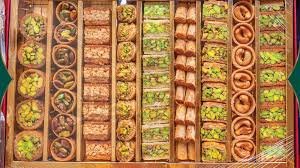
Arabic sweets are an integral part of Middle Eastern and North African cultures, with rich flavors, vibrant colors, and intricate preparations. From honey-soaked pastries to nut-filled delights, these sweets offer a unique blend of textures and tastes that delight the senses. Whether served during special occasions or enjoyed as an everyday treat, Arabic sweets hold a cherished place in the hearts of many across the Arab world. In this article, we will take a deep dive into the history, types, and cultural significance of Arabic sweets, exploring their role in family gatherings, celebrations, and their influence on global cuisine.
What Are Arabic Sweets?
Arabic sweets refer to a wide variety of desserts and confections that are commonly enjoyed in Arab countries. These sweets often feature ingredients such as nuts, honey, dates, yogurt, and sugar, combined with flour or semolina to create a diverse range of treats. Many of these desserts are influenced by centuries of culinary history, blending flavors from Persia, the Levant, North Africa, and the Arabian Peninsula. The use of aromatic spices like cinnamon, cardamom, and rosewater adds a distinctive taste to Arabic sweets, which sets them apart from other global confections.
Common Ingredients in Arabic Sweets
The rich variety of Arabic sweets is largely due to the versatile ingredients used in their creation. Here are some common components:
- Nuts: Almonds, pistachios, cashews, and walnuts are popular in many Arabic sweets and add both flavor and texture.
- Honey and Sugar Syrups: Sweeteners like honey and sugar syrups are essential for binding together pastries and adding that signature sweetness.
- Semolina and Flour: Used as the base for many desserts, semolina creates a hearty, filling texture that pairs beautifully with sweet syrups and fillings.
- Dates: A staple in many Middle Eastern countries, dates are often stuffed, dipped in chocolate, or used as a natural sweetener.
- Aromatic Spices: Cardamom, cinnamon, saffron, and rosewater are frequently used to flavor Arabic sweets, adding layers of depth to their taste.
The Rich History of Arabic Sweets
Arabic sweets have a long and fascinating history that dates back thousands of years. They evolved from the early Middle Eastern desserts that were influenced by the spice trade, with countries like Persia (modern-day Iran) and the Arabian Peninsula at the forefront of developing refined sugar-based treats. During the Islamic Golden Age, the art of making sweets became highly sophisticated, with chefs experimenting with honey, sugar, and spices to create intricate pastries that were both visually stunning and delicious.
The Arab Empire spread its culinary knowledge to parts of North Africa, Spain, and even Southeast Asia, influencing local dessert traditions. Today, Arabic sweets are enjoyed not just in the Arab world, but globally, celebrated for their exotic flavors and time-honored techniques.
Popular Types of Arabic Sweets
There are many types of Arabic sweets, each with its own unique preparation and flavor profile. Below are some of the most beloved desserts from the Arab world:
1. Baklava
Baklava is perhaps the most internationally recognized Arabic sweet, famous for its layers of filo pastry filled with finely chopped nuts and sweetened with syrup or honey. This indulgent pastry is often flavored with cinnamon or cardamom and can be found in many countries across the Arab world, from Lebanon to Turkey. The crispy texture of the filo dough combined with the crunchy nuts and sticky syrup makes baklava a favorite for many.
2. Kunafa
Kunafa is a popular dessert made with thin layers of shredded dough, which are baked to a golden crisp and topped with a generous amount of sweet syrup. The filling is typically made with either a cheese mixture (as in the case of the famous Nabulsi kunafa) or semolina cream. Kunafa is often served warm and is a must-try during Ramadan in many Arab countries. Its combination of sweet, salty, and creamy flavors makes it an unforgettable treat.
3. Ma’amoul
Ma’amoul is a traditional shortbread cookie filled with dates, nuts, or figs. These cookies are typically shaped into small round or oval shapes and stamped with intricate designs. Arabic sweets like ma’amoul are often enjoyed during festive seasons such as Eid, where families gather to celebrate. The delicate texture of the cookies and their sweet fillings make them a perfect accompaniment to a cup of Arabic coffee.
4. Atayef
Atayef are small stuffed pancakes often served during the holy month of Ramadan. These pancakes are typically filled with a sweet mixture of cheese, nuts, or even whipped cream, then folded and fried or baked. The sweetness is intensified with a drizzle of sugar syrup. Arabic sweets like atayef are perfect for breaking the fast during Ramadan, as they offer both energy and a burst of flavor.

5. Basbousa (Hareeseh)
Basbousa, also known as Hareeseh in some parts of the Arab world, is a semolina-based cake that’s soaked in sugar syrup. This sweet treat is often flavored with coconut, almonds, or rosewater, adding an aromatic twist. The moist and dense texture of basbousa makes it a satisfying dessert that is enjoyed year-round.
6. Halawet El Jibn
Halawet El Jibn is a cheese-based dessert that originates from Syria and Lebanon. The dough is made from semolina and cheese, which is then filled with a sweet cream. The dessert is rolled into tubes, topped with sugar syrup, and garnished with crushed pistachios. Halawet El Jibn is a rich and indulgent Arabic sweet that combines the savory and sweet flavors perfectly.
7. Knafeh Nabulsieh
Knafeh Nabulsieh is a variation of Kunafa, originating from the city of Nablus in Palestine. It is made with a cheese base topped with shredded filo dough and sweet syrup, then garnished with crushed pistachios. Known for its delicate balance of sweetness and saltiness, Knafeh Nabulsieh is a dessert beloved by many.
The Cultural Significance of Arabic Sweets
Arabic sweets hold a significant place in Arab culture, often symbolizing hospitality, generosity, and celebration. Offering sweets to guests is a common tradition across the Arab world, and it’s considered a gesture of goodwill and warmth. Whether served during weddings, festivals, or family gatherings, Arabic sweets are an essential part of these occasions.
Sweets and Ramadan
During Ramadan, the month of fasting, Arabic sweets take on an even greater importance. After a day of fasting, the evening meal, known as Iftar, is often accompanied by a variety of desserts. Traditional treats like kunafa, atayef, and qatayef are served to break the fast, providing energy after a long day without food or drink. The act of sharing these sweets strengthens the sense of community and togetherness that defines Ramadan.
Sweets and Weddings
Weddings in the Arab world are lavish celebrations, and Arabic sweets play a key role in these events. Many of the desserts served are deeply symbolic, representing sweetness in the couple’s new life together. Ma’amoul cookies, baklava, and kunafa are often offered to guests as a token of hospitality and to mark the joyous occasion.
The Global Influence of Arabic Sweets
While Arabic sweets are deeply rooted in the Middle Eastern and North African regions, they have also made their mark on the global culinary scene. With the rise of global tourism and increased interest in Middle Eastern cuisine, Arabic sweets have become popular in restaurants, bakeries, and homes worldwide. Many of the ingredients and techniques used in Arabic sweets have inspired chefs and home bakers to experiment with new creations, fusing Arab culinary traditions with global tastes.
Arabic Sweets in the West
In the West, Arabic sweets have found their way into many gourmet bakeries and international dessert menus. Dishes like baklava and kunafa are now served in countries like the United States, the United Kingdom, and beyond. The unique flavors and textures of these sweets appeal to a wide range of palates, and they are often seen as exotic and indulgent treats.
The Popularity of Arabic Sweets Around the World
The accessibility of ingredients like pistachios, almonds, and rosewater, as well as the growing interest in Middle Eastern culture, has led to the global spread of Arabic sweets. Many home cooks now attempt to recreate their favorite Arabic sweets in their own kitchens, and online recipes have made it easier than ever to explore these desserts from afar.
Conclusion
They are more than just desserts; they are an expression of culture, history, and hospitality. From the crunchy layers of baklava to the soft, creamy texture of kunafa, these sweets offer a diverse range of flavors that reflect the richness of the Arab world. Whether you’re celebrating a special occasion or simply enjoying a quiet moment with family, They continue to bring people together, bridging cultures and generations with their sweetness.
For those who have yet to try it, a world of rich flavors and aromatic delights awaits. As global interest in Middle Eastern cuisine grows, these traditional treats are being enjoyed far beyond the borders of the Arab world, ensuring that the legacy of Arabic sweets will continue to sweeten the lives of many for generations to come.



